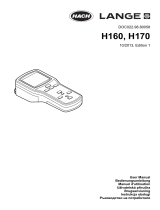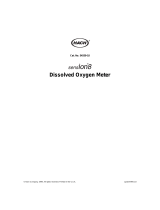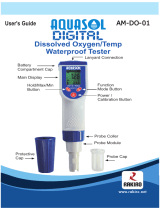Page is loading ...

Cat. No. 54650-18
Portable Multiparameter
Meter Manual
© Hach Company, 2000, 2001. All rights reserved. Printed in the U.S.A. te/dk 5/01 2ed

2

3
TABLE OF CONTENTS
SAFETY PRECAUTIONS ....................................................................................................... 7
SPECIFICATIONS.................................................................................................................... 9
OPERATION........................................................................................................................13
SECTION 1 INTRODUCTION...................................................................................... 15
1.1 Unpacking the Instrument................................................................................................. 15
1.1.1 Standard Accessories............................................................................................... 15
1.1.2 Optional Accessories............................................................................................... 16
1.2 Keypad Description........................................................................................................... 16
1.3 Screen Description and Layout......................................................................................... 18
1.4 Maintenance...................................................................................................................... 20
1.5 Audible Signals................................................................................................................. 20
SECTION 2 INSTRUMENT SETUP............................................................................ 21
2.1 Instrument Description...................................................................................................... 21
2.2 Power Connection ............................................................................................................. 21
2.2.1 Using the Docking Station as a Power Source ........................................................ 21
2.2.2 Docking Station Connections.................................................................................. 23
2.2.3 Using Batteries as a Power Source.......................................................................... 23
2.3 Probe Connections............................................................................................................. 24
2.3.1 Switching Between Conductivity and Dissolved Oxygen Modes........................... 24
2.3.2 Attaching the Probe Holder to the Instrument......................................................... 25
2.4 Turning the Meter On........................................................................................................ 25
2.5 Setup Menu Features Common to All Parameters............................................................ 25
2.6 Printer and Computer Connections................................................................................... 26
2.7 Automatic Shut-off Function ............................................................................................ 26
2.8 Display Backlight.............................................................................................................. 26
SECTION 3 pH OPERATION MODE......................................................................... 27
3.1 pH Setup Menu Options.................................................................................................... 27
3.2 How to Change the pH Menu Options.............................................................................. 28
3.3 pH Calibration................................................................................................................... 30
3.3.1 Performing a Calibration Using Automatically Recognized Buffers...................... 30
3.3.2 Performing a Manual Calibration............................................................................ 31
3.3.3 Reviewing the Calibration....................................................................................... 32
3.4 Measuring Samples........................................................................................................... 33
3.5 Millivolt Measurement...................................................................................................... 33

4
TABLE OF CONTENTS, continued
SECTION 4 CONDUCTIVITY OPERATION MODE............................................ 35
4.1 Conductivity Setup Menu Options ................................................................................... 35
4.2 How to Change the Conductivity Menu Options.............................................................. 38
4.3 Conductivity Calibration................................................................................................... 39
4.3.1 Calibrating with a Known NaCl Standard............................................................... 40
4.3.2 Calibrating with a Known KCl Standard ................................................................ 41
4.3.3 Calibrating by Adjusting the Cell Constant ............................................................ 41
4.3.4 Reviewing Calibrations........................................................................................... 42
4.4 Measuring Conductivity ................................................................................................... 43
4.4.1 Measuring Low Levels of Conductivity.................................................................. 43
4.5 Measuring Total Dissolved Solids.................................................................................... 44
4.6 Measuring Salinity............................................................................................................ 44
4.7 Substances that May Affect Measurement ....................................................................... 45
4.8 Common Conversion Factors............................................................................................ 45
4.9 Theory of Conductivity Measurement.............................................................................. 46
SECTION 5 DISSOLVED OXYGEN OPERATION MODE.................................. 49
5.1 Dissolved Oxygen Setup Menu Options........................................................................... 49
5.2 How to Change the Dissolved Oxygen Menu Options..................................................... 49
5.3 DO Probe .......................................................................................................................... 50
5.3.1 Probe Assembly....................................................................................................... 50
5.4 Dissolved Oxygen Calibration.......................................................................................... 52
5.4.1 Probe Polarization................................................................................................... 52
5.4.2 Zeroing the Probe.................................................................................................... 53
5.4.3 Calibration in Water Saturated Air.......................................................................... 54
5.4.4 Calibration to a Known Dissolved Oxygen Concentration..................................... 55
5.4.5 Calibrating a Sample to Read 100% Saturation...................................................... 56
5.4.6 Calibration Review.................................................................................................. 57
5.5 Measuring Dissolved Oxygen........................................................................................... 58
5.5.1 General Probe Operation......................................................................................... 58
5.5.2 Dissolved Oxygen Measurement ............................................................................ 58
5.5.3 Probe Storage .......................................................................................................... 59
5.5.4 Maintenance............................................................................................................ 60
5.6 Using the BOD Accessory Kit.......................................................................................... 60
5.7 Making BOD Determinations........................................................................................... 61
5.8 Measuring Dissolved Oxygen in Water (0 to 20 mg/L).................................................... 61
5.9 Salinity Correction Factors............................................................................................... 66
5.10 Pressure Conversions...................................................................................................... 67

5
TABLE OF CONTENTS, continued
SECTION 6 STORING AND RECALLING DATA.................................................. 69
6.1 Storing Measurements....................................................................................................... 69
6.2 Recalling Stored Data........................................................................................................ 70
6.2.1 pH Data.................................................................................................................... 71
6.2.2 Conductivity Data.................................................................................................... 71
6.2.3 Dissolved Oxygen Data........................................................................................... 72
6.3 Erasing Data...................................................................................................................... 72
6.3.1 Erasing Single Data Points ...................................................................................... 72
6.3.2 Erasing Multiple Data Points................................................................................... 73
SECTION 7 PRINTING AND DATA TRANSFER ................................................... 75
7.1 Connecting to Printers/Computers.................................................................................... 75
7.1.1 RS232 Cable Description ........................................................................................ 75
7.1.2 Connecting to a Printer............................................................................................ 75
7.1.3 Connecting to a Personal Computer........................................................................ 77
7.1.4 Using HachLink™ Communications Software with a PC ...................................... 78
7.2 Sending Data to Printers/Computers................................................................................. 78
7.2.1 Sending Currently Displayed Data.......................................................................... 78
7.2.2 Sending Recalled Data Points.................................................................................. 78
7.2.3 Sending Multiple Data Points.................................................................................. 79
7.3 Printed Data Formats......................................................................................................... 80
7.3.1 pH Printed Data Format........................................................................................... 80
7.3.2 Conductivity Printed Data Format........................................................................... 80
7.3.3 Dissolved Oxygen Printed Data Format.................................................................. 80
SECTION 8 TROUBLESHOOTING............................................................................ 81
8.1 Error Codes ....................................................................................................................... 81
8.2 Meter Service Request Questionnaire............................................................................... 82
GENERAL INFORMATION...........................................................................................83
REPLACEMENT PARTS AND ACCESSORIES.................................................................. 85
HOW TO ORDER................................................................................................................... 89
REPAIR SERVICE.................................................................................................................. 90
WARRANTY .......................................................................................................................... 91
CERTIFICATION ................................................................................................................... 93

6

8

9
SPECIFICATIONS
Specifications subject to change without notice.
General Specifications
Display: Custom LCD
Inputs:
(1) 5-pin Hach pH/mV/temperature probe connector
(1) 5-pin Hach conductivity or dissolved oxygen probe connector
Outputs: RS232 via Docking Station
Power requirements:
Meter: 4 AA alkaline batteries or via Docking Station
Docking Station: 6–12 V dc; use either Hach-supplied 115
or 230 V, 50/60 Hz external power supply or a
customer-provided supply with 50 mA output, 5.5-mm power
plug with a 2.5 mm center post (positive).
Input impedance: >10
l2
ohms
Installation Category: II (for 115V and 230V external
power supplies)
Environmental Requirements: 0–50 °C at 85% non-condensing
relative humidity
Meter dimensions: 21.2 x 8.7 x 4.2 cm (8.35 x 3.43 x 1.65 inches)
Enclosure: Waterproof (designed to meet IP67), chemical-
resistant, dust proof; meter will float. Docking station is water-
resistant to IP40.

10
SPECIFICATIONS, continued
pH Mode
Range:-2.00–19.99
Resolution (selectable): 0.001/0.01/0.1
Slope (meter allowable): 48–65 mV/decade
Instrument Drift: <40 µV/°C
Input Bias Current: -1 pico amp
≤ input bias ≤ 1 pico amp at
25 °C; ±4 picoamp over full range
Millivolt Mode
Range: -2000–2000 mV
Resolution: 0.1 mV
Accuracy (meter only): ±0.2 mV or ±0.15% of the reading,
whichever is greater
Temperature
Range: -10.0–110 °C
Resolution: 0.1 °C
Accuracy: ±0.3 °C from 0–70 °C; ±1.0 °C from 70–110 °C
Conductivity Mode
Range: 0–19.99 µS; 20–199.9 µS/cm; 200–1999 µS/cm;
2–19.99 mS/cm; 20–199.9 mS/cm
TDS: 0–50,000 mg/L as NaCl
Salinity: 0–42 ppt (‰)
Temperature: -10–105 °C
Resolution:
Conductivity:
0.00–19.99 µS/cm 0.01 µS/cm
20.0–199.9 µS/cm 0.1 µS/cm
200–1999 µS/cm 1 µS/cm
2.00–19.99 mS/cm 0.01 mS/cm
20.0–199.9 mS/cm 0.1 mS/cm

11
SPECIFICATIONS, continued
Resolution:
Accuracy:
Conductivity: ±0.5% of range
TDS: ±0.5% of full scale
Salinity: ±0.1 ppt (-2 to 35°C)
Temperature: ±0.3 °C from 0–70 °C;
±1.0 °C from 70–110 °C
Conversion Factor for TDS: automatic or user adjustable
Temperature Compensation:
Manual (user selected coefficient, % per °C) or
Automatic (non-linear based on NaCl solutions)
Dissolved Oxygen Mode
Range: 0–20 mg/L (ppm), 0–200% sat.
Accuracy: ±1% full scale
Temperature: 0–50 °C
Resolution:
Instrument drift: < 1%/day
TDS:
0.00–199.9 mg/L 0.1 mg/L
200–1999 mg/L 1 mg/L
2.00–19.99 g/L 0.01 g/L
20.0–50 g/L 0.1 g/L
Salinity:
0.1 ppt (‰)
Temperature
±0.1 °C
Oxygen Concentration: 0.01 or 0.1 ppm (mg/L)
% Saturation: 0.1%
Temperature: 0.1 °C

12

13
DANGER
Handling chemical samples, standards, and reagents can be dangerous. Review the necessary
Material Safety Data Sheets and become familiar with all safety procedures before handling
any chemicals.
DANGER
La manipulation des échantillons chimiques, étalons et réactifs peut être dangereuse. Lire les Fiches
de Données de Sécurité des Produits (FDSP) et se familiariser avec toutes les procédures de sécurité
avant de manipuler tous les produits chimiques.
PELIGRO
La manipulación de muestras químicas, estándares y reactivos puede ser peligrosa. Revise las fichas
de seguridad de materiales y familiarícese con los procedimientos de seguridad antes de manipular
productos químicos.
GEFAHR
Das Arbeiten mit chemischen Proben, Standards und Reagenzien ist mit Gefahren verbunden.
Es wird dem Benutzer dieser Produkte empfohlen, sich vor der Arbeit mit sicheren Verfahrensweisen
und dem richtigen Gebrauch der Chemikalien vertraut zu machen und alle entsprechenden
Materialsicherheitsdatenblätter aufmerksam zu lesen.
PERIGO
A manipulação de amostras, padrões e reagentes químicos pode ser perigosa. Reveja a folha dos
dados de segurança do material e familiarize-se com todos os procedimentos de segurança antes
de manipular quaisquer produtos químicos.
OPERATION

14

15
SECTION 1 INTRODUCTION
The portable sension™156 Multiparameter Meter measures pH,
conductivity, and dissolved oxygen. Other features include:
• User-friendly calibration
• 199-point internal datalogging for each of the three
parameters
• Automatic shut-off (15 minutes after the last key press)
• Automatic correction for barometric pressure, and salinity
• Sealed keypad provides IP67 water resistance
• Ability to send data to a printer or computer through the
Docking Station
• Use of alkaline batteries or a Docking Station for power
1.1 Unpacking the Instrument
Remove the instrument and accessories from the shipping
container and inspect each item for damage. Verify that all items
listed on the packing slip are included. If any items are missing or
damaged, contact Hach Customer Service, Loveland, Colorado at
1-800-227-4224. Customers outside the United States should
contact their regional Hach office or distributor.
1.1.1 Standard Accessories
• Batteries—4 alkaline (not rechargeable)
• sension156 Multiparameter Meter Instrument Manual
• Removable dual probe holder
Depending on which configuration you ordered, you will receive
two or more of the following:
• pH electrode
• Conductivity electrode
• Dissolved oxygen electrode

16
SECTION 1, continued
1.1.2 Optional Accessories
• Docking Station
• Stirring Stand
• BOD Accessory Kit (See Section 5.6 on page 60.)
• Low Ionic Strength Sample Chamber
• Probe-related accessories (covered in the electrode manual)
• Carrying case
1.2 Keypad Description
Figure 1 shows the keypad. Table 1 explains key functions.
Figure 1 sension156 Meter and Keypad
READ
enter
exit
store
light
review
erase
time
setup
recall
print
cal
CE
7
8
9
4
5
6
1
2
0
3
.
con
sal
mV
DO
TDS
pH
%

17
SECTION 1, continued
Table 1 Keys and Description
Key Description
Exit/Power On-Off When power is off:
• Turns the instrument on and opens the most recently used reading mode.
In Reading mode:
• Turns the instrument off.
From other power modes:
• Exits the current mode and moves toward power off.
• Acts as a “no” answer when the question mark is flashing.
• Cancels the current operation without saving changes.
UP ARROW and
DOWN ARROW
Scroll between options in setup mode.
Scroll through data points in Store and Recall modes.
Scroll between the option to print or erase one data point and the option to print or
erase multiple data points.
READ/ENTER Accepts numerical input.
Acts as a “yes” answer when the question mark is flashing.
Allows user to edit a setup when the setup number is flashing.
Accepts the current setup option when that option is flashing.
Initiates a measurement when the meter has stabilized in the Display Lock
Enabled mode and during calibration.
RECALL Recalls stored sample data of the current reading parameter type (from Reading
mode only).
STORE Initiates storage of the displayed measurement (from Reading mode only).
ERASE Erases recalled data points.
CON/TDS/SAL Initiates conductivity reading. Toggles between conductivity, total dissolved solids,
and salinity.
pH/mV Initiates pH reading. Toggles between pH and mV.
DO % Initiates dissolved oxygen reading. Toggles between dissolved oxygen
concentrations displayed as % saturation and mg/L in Reading, Data Recall, and
Calibration Review modes.
PRINT Sends current or recalled data to a printer or a computer via the RS232 port on the
docking station. From Cal Review, prints current calibration data.
TIME From Reading Mode, shows current time (one press) and date (two presses). In
Recall Data and Calibration Review modes, the key toggles between the time and
date of the stored measurement.
CAL Enters Calibration mode (from Reading mode only).
REVIEW Enters Calibration Review mode (from Reading mode only).
SETUP/CE Enters setup mode (from Reading mode only).
Clears a numeric entry when the keypad icon is displayed.
LIGHT Turns the backlight on and off.

18
SECTION 1, continued
1.3 Screen Description and Layout
The screen, also known as the display, is divided into two areas
by a horizontal line. The upper area shows measurements or
standard values, the current operation mode, sample temperature,
units, error codes, and a stable reading indicator. The lower area
shows the active navigation keys (
ENTER, EXIT, or UP ARROW
and
DOWN ARROW keys). It also shows when the numeric keypad
is active and AC power is connected via the Docking Station.
Figure 2 shows the icons and fields that appear on the display.
Table 2 describes each icon and field. To see all icons
simultaneously, hold down the
POWER key for several seconds.
Figure 2 sension156 Display Layout
F
mV
?
RECALL
Print
Store
Erase
Sample
Standard
All
CAL
REVIEW
?
ERROR
C
Default
Date
Time
setup
Stabilizing...
c m
Slope
enterexit
789
456
123
!
Conductivity
(
Off
)
Sal
TDS
CORRECTION
DO
19
20
21
23
24 22
2526
27
28
30
29
31
32
33
34
35
36
37
38
39
12 4
356
9
10
11
12
13
14
15
16
17
18
7
8

19
SECTION 1, continued
Table 2 Display Descriptions
Item No. Description
1 Indicates meter is in Calibration mode. When this icon and the ? are flashing, a calibration
is necessary.
2 Indicates meter is in Calibration Review mode.
3 Indicates the battery is low.
4 Indicates data is being or will be sent to a printer/computer, or that a printing setup has
been accessed.
5 Indicates currently displayed recalled data is being or will be erased.
6 Indicates meter is in setup mode.
7 Indicates all data points are being printed or erased. Also used when displaying pH
average.
8 Refers to
Setup, Sample, or Standard when any of those words are displayed next to the
number. For example, if
Standard and 1 are displayed, the meter is measuring Standard 1.
9 When flashing along with the CAL icon, indicates that calibration is needed for the current
reading parameter. Otherwise, it indicates that user input is required.
(In this case, press ENTER for “yes” and EXIT for “no”.)
10 Label for sample number in Data Store, Recall, or Erase modes.
11 Indicates the meter is measuring a standard (standard number is displayed above).
12 Indicates the displayed number is the electrode slope.
13 Main numeric display field. Displays values for readings, slope, and setups.
14 Indicates measurement units.
15 Indicates the meter is using the default temperature to calculate temperature correction.
(Probe temperature sensor is not functioning.)
16 Indicates the temperature units in use (choice of °C or °F).
17 Indicates value displayed in small numerical field (item 18) is in millivolts.
18 Displays temperature value, date, or pH calibration offset.
19 Indicates the meter is using AC power (only displayed when in the docking station).
20 Indicates an inactive key has been pressed and that function is not allowed.
21 Indicates the ENTER key is active.
22 Indicates the date is being set (in Setup mode) or displayed (in Reading, Cal Review, or
Data Recall mode).
23 Indicates arrow keys are active.
24 Indicates that the instrument is reading or recalling conductivity in terms of TDS. If
correction icon is also on, it indicates that the TDS correction factor has been changed from
the factory default.
25 Indicates that the meter is in Correction mode. Indicates that one or more correction factor
setups have been changed from their default settings. These include salinity correction for
DO, and temperature and/or TDS correction factors for conductivity.

20
SECTION 1, continued
1.4 Maintenance
The meter is designed to be maintenance-free. If the meter gets
dirty, wipe the surface with a damp cloth. Use a cotton-tipped
applicator to clean or dry the connectors if they get wet.
1.5 Audible Signals
The meter will beep under certain conditions:
• when a non-functional key press is made (one beep)
• when measurement stability is reached during calibration
(three beeps)
• in Reading mode, when the display lock is turned on and
stability is reached (three beeps)
• in case of an error or malfunction (one beep).
26 Indicates EXIT key is active.
27 If the thermometer icon and the correction icon are on, a temperature correction other than
the factory default is in use. If it is on with the
(Off) icon, temperature compensation is
turned off.
28 Indicates numeric key functions are active.
29 In Conductivity mode, it indicates the meter is displaying sample salinity. In DO mode,
indicates that the salinity correction is being applied to the dissolved oxygen measurement
and that the salinity corrected value is displayed.
30 Indicates the display is locked. Pressing read initiates another measurement.
31 Indicates a meter function problem.
32 Indicates whether an associated setup setting is
On or Off.
33 Indicates faulty probe connection or incorrect probe attached.
34 Indicates that the meter is reading or recalling a dissolved oxygen measurement.
35 Indicates that the instrument is reading or recalling a conductivity measurement.
36 Indicates the signal from the sample is not yet stable. When the icon disappears, the
reading is stable and may be recorded.
37 Asks if the calibration or the displayed sample data should be stored. Used with ? icon.
38 Indicates the time is being displayed or set. Used with large display (item 13).
39 Indicates the meter is in Recall mode and the displayed data is stored data.
Table 2 Display Descriptions (Continued)
Item No. Description
/













